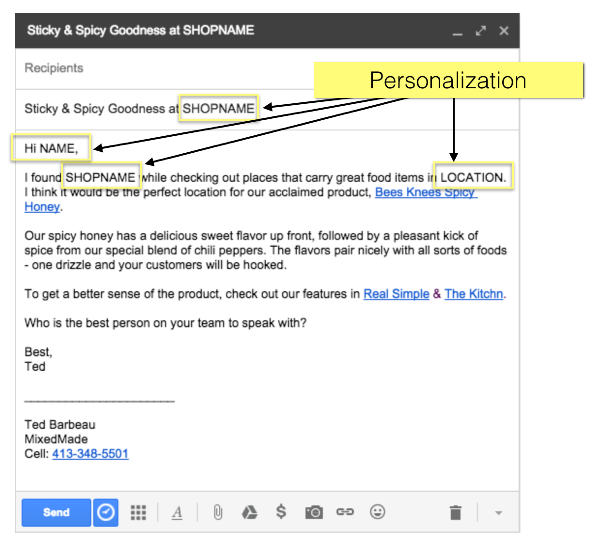At the end of 2014, there were 19 retailers carrying Bushwick Kitchen products, heavily concentrated in Brooklyn & Manhattan. Fast forward to today and our products now grace the shelves of 265 retail locations in 38 states around the US & Canada.
In other words, we grew our retail footprint by 734% in one year, which resulted in $220,000 in gross revenue in 2015.
Not bad, right?
To be frank, it was a ton of work, replete with nerve-wracking trials and head-scratching errors. We cobbled together strategies learned from fellow food entrepreneurs, tactics borrowed from the world of growth hacking, and some good ol’ fashioned sales moxy. (Thanks Glengarry Glen Ross!)
In the end, we started to reap the rewards for our efforts. But what was most surprising was how straight-forward our process was.
While there is no silver bullet to building a wholesale business, if I were forced to boil our results down to a simple formula, it would look something like this:
(Sound Strategy + Full Team Support) x Sustained Effort = Results
In plain English: If you develop a sound strategy and enlist the full support of your team, then execute against that strategy consistently and vigorously over an extended period of time, you will see results.
In early 2015, we mapped out a plan that encompassed each component of that equation by asking ourselves the following questions:
- What’s our plan to rapidly acquire new retail partners? (Strategy!)
- What internal resources do we need to fulfill this growth? (Support!)
- Um, how do I do this without getting burned out? (Effort!)
Let me tell you a little bit more about each.
Strategy
If you recall, I wrote about how we launched our wholesale strategy in a post last April.
Boy have things changed since then.
In short, we’ve completely rewritten the script on how we 1) identify and 2) contact new retail partners. If you read both posts back-to-back, it might feel more like a tweak to our old process but a few small changes really did make all of the difference.
Identify
Previously, my advice was to spend copious amounts of time researching your current retail list, Googling/Yelping potential partners, and networking with other food makers. While this strategy sounds great on paper (and by all accounts led us to some great retailers), it just didn’t scale. I constantly felt as though I was struggling to find the right retailers for our products.
To use sales parlance, we needed to do a better job filling the top of our funnel or else we would never grow our wholesale business.
The solution was so painfully obvious that I was embarrassed when a fellow food entrepreneur pointed it out to me. His advice was:
It’s so simple I’m still shocked I hadn’t thought of it before.
This tactic was a game-changing piece of advice for a couple reasons:
- Better leads: It allowed us to source pre-vetted leads since the retailer already carries products that often share shelf space with Bushwick Kitchen products.
- Increased speed: There is no faster way to build a list of retailers. Some food makers have lists of hundreds of retail partners on their website, which saves you an immeasurable amount of time.
Simply put, this strategy can help you fill the top of your funnel, creating more opportunities and eventually more retailers carrying your products.
Contacting
(Note: This section could, and will be, a lengthy post unto itself. I’m going to give a brief overview here but will definitely do a deep dive on this in the future.)
Much of our original advice still stands here. We greatly prefer email to phone calls as we’ve found that it is much easier for initial contact. The phone is a great way to build rapport with partners but in order to contact large amounts of retailers, email is king.
A key change that we made was to double-down on personalizing each email to the individual we were attempting to contact. As you can see, we add 4 pieces of personalized information before the end of the very first sentence.

Based on our conversion rates (overall about 30%), we’re confident that this is a key differentiation for us. Shop owners and buyers receive hundreds of emails a week. You need to find unique ways to cut through the noise and get them to keep reading.
I will generally continue to contact a lead each week for about 4 or 5 weeks before putting them into a “contact later” folder in my inbox. I’ll reach back out once we have some new products or news to share that might entice them to engage.
Effort
As the equation shows, sustained effort to retailer outreach is the key multiplier. In order to grow, we knew we needed to increase the number of retailers we were contacting.
We set an absurd goal of trying to reach 100 new retailers each week. I’m happy to report that I failed miserably in this regard. To manage that level of email volume is wishful thinking to say the least. Just think about it: If you send an email to 100 new retailers each week, and plan to follow up with them for about 5 weeks, you end up with a massive number of emails to get through by the fifth week. This just illustrates how quickly email can get out of hand.
|
Week 1 |
Week 2 |
Week 3 |
Week 4 |
Week 5 |
|
|
Group 1 |
100 |
90 |
80 |
70 |
60 |
|
Group 2 |
100 |
90 |
80 |
70 |
|
|
Group 3 |
100 |
90 |
80 |
||
|
Group 4 |
100 |
90 |
|||
|
Group 5 |
100 |
||||
|
Total Emails |
100 |
190 |
270 |
340 |
400 |
As you can see, sending 400 emails in an organized fashion can quickly become a challenge.
In the end, we reached out to roughly 500 retailers over the course of about 6 months and converted about 30% of them.
A not-so-scientific breakdown of how we acquired retailers looks something like this:
|
Starting retailers |
19 |
|
|
Outbound sales |
150 |
(500 contacted with 30% converted) |
|
Inbound leads |
50 |
(Estimate) |
|
Misc. |
46 |
(Trade shows, friendly intros, etc.) |
|
Total |
265 |
(Note: We have a saying internally that “retailers beget retailers.” What I mean by this is that there is a snowball effect to adding retailers. The food world is a very small community and you would be surprised at how many shop owners and buyers look to each other’s stores for inspiration. I would say that about 10% of our inbound leads start with something along the lines of “I was at this great little shop in San Diego and stumbled upon your products…”)
Support
I’ll keep this brief, but without the support of Casey and our production/fulfillment team, our equation falls apart and we never would have been able to grow at such a pace. His directive to me was essentially “if you can keep bringing in more retailers, we’ll get wholesale cases out the door no questions asked.”
The fact that we were able to ship 35,000 bottles of Bushwick Kitchen products in one year still boggles my mind.
I’ll goad Casey into breaking down how we’ve been able to manage production for a company growing at our pace soon soon. Stayed tuned.
Results
As I mentioned right off the bat, we grew our retail footprint by 734% and generated $220,000 in wholesale revenue in 2015. It’s just one small step in the direction of our ultimate goals, but it was a step nonetheless.
I didn’t do a great job tracking exactly how many retailers we acquired each month, or exactly how many retailers “churned” over time because they no longer wanted to carry our products for one reason or another. However, our revenue chart does a pretty good job showing how our wholesale business grew on a month-to-month basis in 2015:

This feels great for one simple reason: Bigger bars equal more retailers and more revenue! (Keep in mind that our products are incredibly giftable, and therefore are purchased by the armful during Q4.)
Looking Ahead
Specialty food is a competitive world, and we don’t have the luxury of resting on our laurels. Our wholesale goals for 2016 reflect our hunger to share our delicious products with the world. Here are just a few of them:
- 1,000 Retail Locations: We’d like to quadruple our retail footprint and see Bushwick Kitchen products on the shelves of 1,000 different retail locations.
- 3-5 Large Retailers: In order to make this leap, we know we need to start working with more national and regional retailers. We’d like to add 3-5 larger retailers (20 locations or more) to help expand into new markets faster.
- Measurement: While we kept our eyes on the larger metrics (e.g. new retailers & revenue) on a quarterly basis, we didn’t do a good job at quantifying our efforts on a more granular level. While these metrics are still being developed, we want to continue to learn from our efforts and continually get better.
Leave a comment if you have any suggestions for how we could improve our sales process.
—Ted
